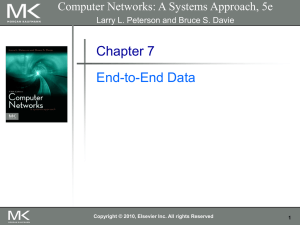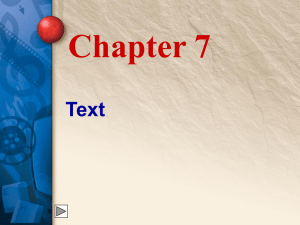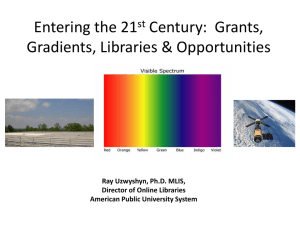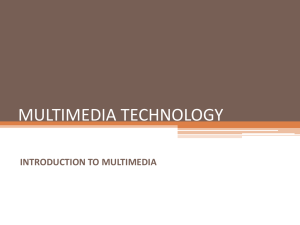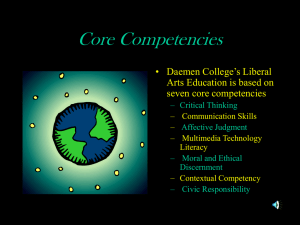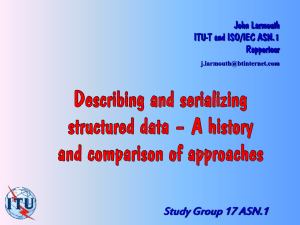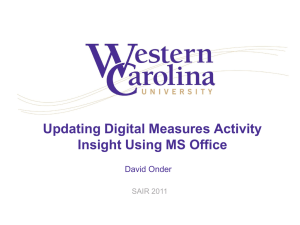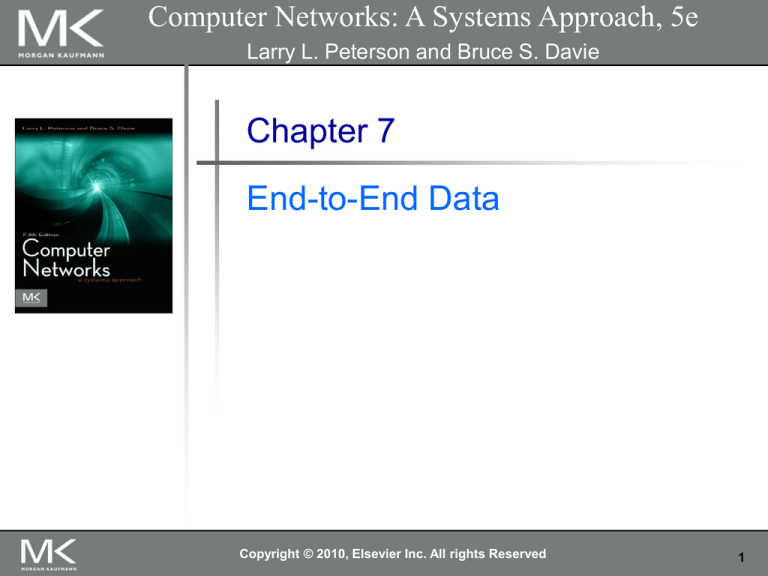
Computer Networks: A Systems Approach, 5e
Larry L. Peterson and Bruce S. Davie
Chapter 7
End-to-End Data
Copyright © 2010, Elsevier Inc. All rights Reserved
1
From the network’s perspective, application
programs send messages to each other.
Each of these messages is just an uninterpreted
string of bytes.
From the application’s perspective, however,
these messages contain various kinds of data—
arrays of integers, video frames, lines of text,
digital images, and so on. In other words, these
bytes have meaning.
Chapter 7
Problem
2
Chapter 7
Problem
We now consider the problem of how best to
encode the different kinds of data that
application programs want to exchange into byte
strings.
3
Chapter 7
Chapter Outline
Presentation Formatting
Multimedia Data
4
Chapter 7
Presentation Formatting
One of the most common transformations of
network data is from the representation used by
the application program into a form that is
suitable for transmission over a network and vice
versa.
This transformation is typically called
presentation formatting.
5
Chapter 7
Presentation Formatting
The sending program translates the data it wants
to transmit from the representation it uses
internally into a message that can be transmitted
over the network; that is, the data is encoded in
a message.
On the receiving side, the application translates
this arriving message into a representation that it
can then process; that is, the message is
decoded. Encoding is sometimes called
argument marshalling, and decoding is
sometimes called unmarshalling. This
terminology comes from the RPC world.
6
Chapter 7
Presentation Formatting
Presentation formatting involves
encoding and decoding application
data
7
Chapter 7
Presentation Formatting
Big-endian and little-endian byte order
for the integer 34,677,374.
8
Chapter 7
Presentation Formatting
Taxonomy
Data Types
The first question is what data types the system is going to
support. In general, we can classify the types supported by
an argument marshalling mechanism at three levels.
At the lowest level, a marshalling system operates on some set of base
types. Typically, the base types include integers, floating-point numbers,
and characters. The system might also support ordinal types and
booleans.
At the next level are flat types—structures and arrays.
At the highest level, the marshalling system might have to deal with
complex types—those types that are built using pointers
In summary, depending on how complicated the type system is, the
task of argument marshalling usually involves converting the base
types, packing the structures, and linearizing the complex data
structures, all to form a contiguous message that can be transmitted
over the network
9
Chapter 7
Presentation Formatting
Argument marshalling: converting,
packing, and linearizing
10
Chapter 7
Presentation Formatting
Conversion Strategy
Once the type system is established, the next issue is
what conversion strategy the argument marshaller will
use. There are two general options:
canonical intermediate form and receiver-makes-right
11
Chapter 7
Presentation Formatting
Conversion Strategy
The idea of canonical intermediate form is to settle on an
external representation for each type; the sending host
translates from its internal representation to this external
representation before sending data, and the receiver
translates from this external representation into its local
representation when receiving data
The alternative, which is sometimes called receiver-makesright, has the sender transmit data in its own internal format;
the sender does not convert the base types, but usually has
to pack and flatten more complex data structures. The
receiver is then responsible for translating the data from the
sender’s format into its own local format
12
Chapter 7
Presentation Formatting
Tags
The third issue in argument marshalling is how the
receiver knows what kind of data is contained in the
message it receives. There are two common
approaches: tagged and untagged data.
A tag is any additional information included in a message—
beyond the concrete representation of the base types—that
helps the receiver decode the message.
The alternative, of course, is not to use tags. How does the
receiver know how to decode the data in this case? It knows
because it was programmed to know.
13
Chapter 7
Presentation Formatting
Tags
A 32-bit integer encoded in a tagged
message
14
Chapter 7
Presentation Formatting
Stubs
A stub is the piece of code that implements argument
marshalling.
Stubs are typically used to support RPC. On the client
side, the stub marshalls the procedure arguments into
a message that can be transmitted by means of the
RPC protocol.
On the server side, the stub converts the message
back into a set of variables that can be used as
arguments to call the remote procedure.
Stubs can either be interpreted or compiled
15
Chapter 7
Presentation Formatting
Stubs
Stub compiler takes interface description as input
and outputs client and server stubs.
16
Chapter 7
Presentation Formatting
Examples
XDR
External Data Representation (XDR) is the network format
used with SunRPC. In the taxonomy just introduced, XDR
supports the entire C type system with the exception of function
pointers
defines a canonical intermediate form
does not use tags (except to indicate array lengths)
uses compiled stubs
17
Chapter 7
Presentation Formatting
Examples
XDR
An XDR integer is a 32-bit data item that encodes a C
integer.
It is represented in twos complement notation, with the most
significant byte of the C integer in the first byte of the XDR
integer, and the least significant byte of the C integer in the
fourth byte of the XDR integer.
That is, XDR uses big-endian format for integers.
XDR supports both signed and unsigned integers, just as C
does.
18
Chapter 7
Presentation Formatting
Examples
XDR
XDR represents variable-length arrays by first specifying an
unsigned integer (4 bytes) that gives the number of elements
in the array, followed by that many elements of the
appropriate type.
XDR encodes the components of a structure in the order of
their declaration in the structure.
For both arrays and structures, the size of each element/
component is represented in a multiple of 4 bytes. Smaller
data types are padded out to 4 bytes with 0s.
The exception to this “pad to 4 bytes” rule is made for
characters, which are encoded one per byte.
19
Chapter 7
Presentation Formatting
Examples
XDR
Example encoding of a structure in XDR
20
Chapter 7
Presentation Formatting
Examples
ASN.1
Abstract Syntax Notation One (ASN.1) is an ISO standard
that defines, among other things, a representation for data
sent over a network.
The representation-specific part of ASN.1 is called the Basic
Encoding Rules (BER).
ASN.1 supports the C type system without function pointers,
defines a canonical intermediate form, and uses type tags.
Its stubs can be either interpreted or compiled.
One of the claims to fame of ASN.1 BER is that it is used by
the Internet standard Simple Network Management Protocol
(SNMP).
21
Chapter 7
Presentation Formatting
Examples
ASN.1
ASN.1 represents each data item with a triple of the form
< tag, length, value >
The tag is typically an 8-bit field, although ASN.1 allows for
the definition of multi-byte tags.
The length field specifies how many bytes make up the value;
Compound data types, such as structures, can be
constructed by nesting primitive types
22
Chapter 7
Presentation Formatting
Examples
ASN.1
Compound types created by means of
nesting in ASN.1/BER
ASN.1/BER representation for a 4-byte
integer
23
Chapter 7
Presentation Formatting
Examples
NDR
Network Data Representation (NDR) is the data-encoding
standard used in the Distributed Computing Environment
Unlike XDR and ASN.1, NDR uses receiver-makes-right. It
does this by inserting an architecture tag at the front of each
message; individual data items are untagged.
NDR uses a compiler to generate stubs.
This compiler takes a description of a program written in the Interface
Definition Language (IDL) and generates the necessary stubs
IDL looks pretty much like C, and so essentially supports the C type
system.
24
Chapter 7
Presentation Formatting
Examples
NDR
ASN.1/BER representation for length: (a) 1
byte; (b) multibyte
NDR’s architecture tag
25
Chapter 7
Presentation Formatting
Markup Languages – XML
Markup languages, of which HTML and XML are both
examples, take the tagged data approach to the
extreme.
Data is represented as text, and text tags known as
markup are intermingled with the data text to express
information about the data.
In the case of HTML, markup merely indicates how
the text should be displayed; other markup languages
like XML can express the type and structure of the
data
26
Chapter 7
Presentation Formatting
Markup Languages – XML
XML syntax looks much like HTML.
For example, an employee record in a hypothetical
XML-based language might look like the XML
document (next slide), which might be stored in a file
named employee.xml.
The first line indicates the version of XML being used,
and the remaining lines represent four fields that
make up the employee record, the last of which (hire
date) contains three sub-fields.
27
Chapter 7
Presentation Formatting
Markup Languages – XML
In other words, XML syntax provides for a nested
structure of tag/value pairs, which is equivalent to a
tree structure for the represented data (with employee
as the root).
This is similar to XDR, ASN.1, and NDR’s ability to
represent compound types, but in a format that can be
both processed by programs and read by humans.
More importantly, programs such as parsers can be
used across different XML-based languages, because
the definitions of those languages are themselves
expressed as machine-readable data that can be
input to the programs.
28
Chapter 7
Presentation Formatting
Markup Languages – XML
<?xml version="1.0"?>
<employee>
<name>John Doe</name>
<title>Head Bottle Washer</title>
<id>123456789</id>
<hiredate>
<day>5</day>
<month>June</month>
<year>1986</year>
</hiredate>
</employee>
29
Chapter 7
Presentation Formatting
Markup Languages – XML
The definition of a specific XML-based language is
given by a schema, which is a database term for a
specification of how to interpret a collection of data.
There are a number of schema languages defined for
XML.
We will focus here on the leading standard, known by
the none-too-surprising name XML Schema.
An individual schema defined using XML Schema is
known as an XML Schema Document (XSD).
30
Chapter 7
Presentation Formatting
Markup Languages – XML
The XSD for the employee.xml example is shown in
the next slide
it defines the language to which the example document
conforms. It might be stored in a file named employee.xsd.
31
Chapter 7
Presentation Formatting
Markup Languages – XML
<?xml version="1.0"?>
<schema xmlns="http://www.w3.org/2001/XMLSchema">
<element name="employee">
<complexType>
<sequence>
<element name="name" type="string"/>
<element name="title" type="string"/>
<element name="id" type="string"/>
<element name="hiredate">
<complexType>
<sequence>
<element name="day" type="integer"/>
<element name="month" type="string"/>
<element name="year" type="integer"/>
</sequence>
</complexType>
</element>
</sequence>
</complexType>
</element>
</schema>
32
Multimedia data, comprising audio, video, and still
images, now makes up the majority of traffic on the
Internet by many estimates.
Chapter 7
Multimedia Data
This is a relatively recent development—it may be hard to believe
now, but there was no YouTube before 2005.
Part of what has made the widespread transmission of
multimedia across networks possible is advances in
compression technology.
Because multimedia data is consumed mostly by
humans using their senses—vision and hearing—and
processed by the human brain, there are unique
challenges to compressing it.
33
Chapter 7
Multimedia Data
You want to try to keep the information that is most
important to a human, while getting rid of anything that
doesn’t improve the human’s perception of the visual or
auditory experience.
Hence, both computer science and the study of human
perception come into play.
In this section we’ll look at some of the major efforts in
representing and compressing multimedia data.
34
To get a sense of how important compression has been to the
spread of networked multimedia, consider the following example.
A high-definition TV screen has something like 1080 × 1920 pixels,
each of which has 24 bits of color information, so each frame is 1080
× 1920 × 24 = 50Mb and so if you want to send 24 frames per
second, that would be over 1Gbps.
That’s a lot more than most Internet users can get access to, by a
good margin.
By contrast, modern compression techniques can get a reasonably
high quality HDTV signal down to the range of 10 Mbps, a two order
of magnitude reduction, and well within the reach of many
broadband users.
Similar compression gains apply to lower quality video such as
YouTube clips—web video could never have reached its current
popularity without compression to make all those entertaining videos
fit within the bandwidth of today’s networks.
Chapter 7
Multimedia Data
35
Chapter 7
Multimedia Data
Lossless Compression Techniques
In many ways, compression is inseparable from data encoding.
That is, in thinking about how to encode a piece of data in a set of bits, we
might just as well think about how to encode the data in the smallest set of
bits possible.
For example, if you have a block of data that is made up of the 26 symbols A
through Z, and if all of these symbols have an equal chance of occurring in
the data block you are encoding, then encoding each symbol in 5 bits is the
best you can do (since 25 = 32 is the lowest power of 2 above 26).
If, however, the symbol R occurs 50% of the time, then it would be a good
idea to use fewer bits to encode the R than any of the other symbols.
In general, if you know the relative probability that each symbol
will occur in the data, then you can assign a different number of
bits to each possible symbol in a way that minimizes the number
of bits it takes to encode a given block of data.
This is the essential idea of Huffman codes, one of the important
early developments in data compression.
36
Chapter 7
Multimedia Data
Lossless Compression Techniques
Run length Encoding
Run length encoding (RLE) is a compression technique with a
brute-force simplicity.
The idea is to replace consecutive occurrences of a given
symbol with only one copy of the symbol, plus a count of how
many times that symbol occurs—hence the name “run
length.”
For example, the string AAABBCDDDD would be encoded as
3A2B1C4D.
37
Chapter 7
Multimedia Data
Lossless Compression Techniques
Differential Pulse Code Modulation
Another simple lossless compression algorithm is Differential
Pulse Code Modulation (DPCM).
The idea here is to first output a reference symbol and then,
for each symbol in the data, to output the difference between
that symbol and the reference symbol.
For example, using symbol A as the reference symbol, the
string AAABBCDDDD would be encoded as A0001123333
since A is the same as the reference symbol, B has a
difference of 1 from the reference symbol, and so on.
38
Chapter 7
Multimedia Data
Lossless Compression Techniques
Dictionary based Methods
The final lossless compression method we consider is the
dictionary-based approach, of which the Lempel-Ziv (LZ)
compression algorithm is the best known.
The Unix compress and gzip commands use variants of the
LZ algorithm.
The idea of a dictionary-based compression algorithm is to
build a dictionary (table) of variable-length strings (think of
them as common phrases) that you expect to find in the data,
and then to replace each of these strings when it appears in
the data with the corresponding index to the dictionary.
39
Chapter 7
Multimedia Data
Lossless Compression Techniques
Dictionary based Methods
For example, instead of working with individual characters in
text data, you could treat each word as a string and output
the index in the dictionary for that word.
To further elaborate on this example, the word “compression”
has the index 4978 in one particular dictionary; it is the
4978th word in /usr/share/dict/words.
To compress a body of text, each time the string
“compression” appears, it would be replaced by 4978.
40
Chapter 7
Multimedia Data
Image Representation and Compression
Given the increase in the use of digital imagery in
recent years—this use was spawned by the invention
of graphical displays, not high-speed networks—the
need for standard representation formats and
compression algorithms for digital imagery data has
grown more and more critical.
In response to this need, the ISO defined a digital
image format known as JPEG, named after the Joint
Photographic Experts Group that designed it. (The
“Joint” in JPEG stands for a joint ISO/ITU effort.)
41
Chapter 7
Multimedia Data
Image Representation and Compression
JPEG is the most widely used format for still images in
use today.
At the heart of the definition of the format is a
compression algorithm, which we describe below.
Many techniques used in JPEG also appear in MPEG,
the set of standards for video compression and
transmission created by the Moving Picture Experts
Group.
42
Chapter 7
Multimedia Data
Image Representation and Compression
Digital images are made up of pixels (hence the
megapixels quoted in digital camera advertisements).
Each pixel represents one location in the twodimensional grid that makes up the image, and for
color images, each pixel has some numerical value
representing a color.
There are lots of ways to represent colors, referred to
as color spaces: the one most people are familiar with
is RGB (red, green, blue).
43
Image Representation and Compression
Chapter 7
Multimedia Data
You can think of color as being three dimensional
quantity—you can make any color out of red, green
and blue light in different amounts.
In a three-dimensional space, there are lots of
different, valid ways to describe a given point
(consider Cartesian and polar co-ordinates, for
example).
Similarly, there are various ways to describe a color
using three quantities, and the most common
alternative to RGB is YUV. The Y is luminance,
roughly the overall brightness of the pixel, and U and
V contain chrominance, or color information.
44
Chapter 7
Multimedia Data
Image Representation and Compression
Let’s look at the example of the Graphical Interchange
Format (GIF).
GIF uses the RGB color space, and starts out with 8 bits to
represent each of the three dimensions of color for a total of
24 bits.
Rather than sending those 24 bits per pixel, however, GIF
first reduces 24-bit color images to 8-bit color images.
This is done by identifying the colors used in the picture, of
which there will typically be considerably fewer than 224, and
then picking the 256 colors that most closely approximate the
colors used in the picture.
There might be more than 256 colors, however, so the trick is
to try not to distort the color too much by picking 256 colors
such that no pixel has its color changed too much.
45
Chapter 7
Multimedia Data
Image Representation and Compression
Block diagram of JPEG compression
46
Chapter 7
Multimedia Data
JPEG Compression
DCT Phase
DCT is a transformation closely related to the fast Fourier
transform (FFT). It takes an
8 × 8 matrix of pixel values as input and outputs an 8 × 8
matrix of frequency coefficients.
You can think of the input matrix as a 64-point signal that is
defined in two
spatial dimensions (x and y); DCT breaks this signal into 64
spatial frequencies.
47
Chapter 7
Multimedia Data
JPEG Compression
DCT Phase
DCT, along with its inverse, which is performed during
decompression, is defined by the following formulas:
where pixel(x, y) is the grayscale value of the pixel at position
(x, y) in the 8×8 block being compressed; N = 8 in this case
48
Chapter 7
Multimedia Data
JPEG Compression
Quantization Phase
The second phase of JPEG is where the compression
becomes lossy.
DCT does not itself lose information; it just transforms the
image into a form that makes it easier to know what
information to remove.
Quantization is easy to understand—it’s simply a matter of
dropping the insignificant bits of the frequency coefficients.
49
Chapter 7
Multimedia Data
JPEG Compression
Quantization Phase
The basic quantization equation is
QuantizedValue(i, j) = IntegerRound(DCT(i, j)/Quantum(i, j))
Where
Decompression is then simply defined as
DCT(i, j) = QuantizedValue(i, j) × Quantum(i, j)
50
Chapter 7
Multimedia Data
JPEG Compression
Encoding Phase
The final phase of JPEG encodes the quantized frequency
coefficients in a compact form.
This results in additional compression, but this compression
is lossless.
Starting with the DC coefficient in position (0,0), the
coefficients are processed in the zigzag sequence.
Along this zigzag, a form of run length encoding is used—
RLE is applied to only the 0 coefficients, which is significant
because many of the later coefficients are 0.
The individual coefficient values are then encoded using a
Huffman code.
51
Chapter 7
Multimedia Data
Video Compression (MPEG)
We now turn our attention to the MPEG format,
named after the Moving Picture Experts Group that
defined it.
To a first approximation, a moving picture (i.e., video)
is simply a succession of still images—also called
frames or pictures—displayed at some video rate.
Each of these frames can be compressed using the
same DCT-based technique used in JPEG.
52
Chapter 7
Multimedia Data
Video Compression (MPEG)
Sequence of I, P, and B frames
generated by MPEG.
53
Chapter 7
Multimedia Data
Video Compression (MPEG)
Frame Types
MPEG takes a sequence of video frames as input and
compresses them into three types of frames, called I frames
(intrapicture), P frames (predicted picture), and B frames
(bidirectional predicted picture).
Each frame of input is compressed into one of these three
frame types. I frames can be thought of as reference frames;
they are self-contained, depending on neither earlier frames
nor later frames.
54
Chapter 7
Multimedia Data
Video Compression (MPEG)
Each frame as a collection of macroblocks
55
Chapter 7
Multimedia Data
Video Compression (MPEG)
Format of an MPEG-compressed video stream
56
Chapter 7
Summary
We have discussed how to represent how to
represent data in the network
We have discussed different compression
techniques for handling multimedia data in the
network
57

